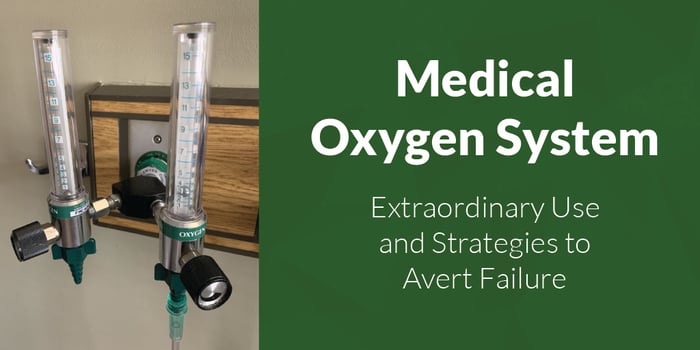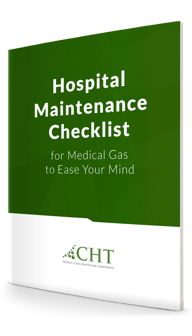
As we move into 2023, there continues to be an increased demand for oxygen delivery systems. Oxygen remains a critical resource in any disaster management. Unfortunately, as we learned through the Covid-19 pandemic, the oxygen delivery infrastructure can struggle under stress, leading to a deficit of medical oxygen in areas where it is needed most.
Strategic management of oxygen supplies remains a priority. Hospitals have large supplies of liquid oxygen and a supply of compressed gas oxygen cylinders that allow several days of the reserve, but a large influx of patients can strain these resources.
As a leader in the control, management, and monitoring of medical gas systems, our commitment to healthcare facility managers encourages us to stay on top of the preventative measures you can take to keep disruption in the oxygen supply chain shortage from affecting your facility's oxygen and medical gas systems.

Maintaining Gas Flow Through Extraordinary Use
Oxygen is often stored as a liquid around minus 300 degrees Fahrenheit to take up less space.
The amount of cold liquid oxygen needed to be delivered through the pipes during stressful times, as in a pandemic, could freeze the equipment.
Some healthcare professionals may think they are experiencing an oxygen shortage when, in reality, it’s not a shortage of oxygen that is the problem.
Their systems have encountered a gas flow so high that the liquid oxygen doesn’t have time to vaporize and freezes the regulators, causing a sudden reduction of flow.
As healthcare facility managers, there are ways to mitigate and take preventative measures to keep the oxygen and medical gas systems running effectively and efficiently during unusual times.
13 Preventative Measures You Can Implement Today to Focus on Tomorrow's Patient Needs
Hospitals' medical gas systems underwent extreme stress during the pandemic due to the crucial treatments required by COVID-19 patients. Concerns about their medical system's capabilities persist today. The concern is that unscalable medical oxygen supply systems will be insufficient if another usage surge occurs.
There eventually comes a critical point in which the safe operation of the system will reach its limit, which could cause a shutdown of the entire bulk medical oxygen system.
The strategies outlined below can be implemented today or used in future planning to help alleviate the problem. These mitigation steps will impact the medical gas infrastructure for the better.
1. Monitor for Excess Ice Buildup and Deice Vaporizers
An increased high flow of oxygen can be the cause of ice accumulation on the vaporizers. A quick observation of your bulk medical oxygen system will show any distress or signs of icing. Spray your vaporizer with a hose to melt the ice. Another way to gain control is to deice using steam.
DO NOT chip at the ice with hammers or ice picks. It may cause a hazard due to falling ice and potentially damages the equipment. Instead, talk to your supplier about getting the vaporizer deiced.
Note: Portable heaters should not be used on oxygen systems.
The video is meant to help medical gas professionals and healthcare facilities better understand the impact of treating COVID-19 patients on a hospital's medical gas systems.
Source: MGPHO Medical Gas, Impact of COVID-19 on Medical Gas System, via YouTube
2. Increase the Size of the Facility’s Vaporizers or Switch Between Vaporizers
Switching between vaporizers (most hospitals have more than one) more frequently, such as every six hours instead of 12 hours, prevents ice buildup.
(source: The Cold, Hard Work of Delivering Oxygen to Ventilators)
3. Increase the Number of Back-Up Canisters at the Hospital
Extra storage of canisters can serve as a backup in emergencies.
Oxygen gas can be compressed and stored in cylinders. If possible, switch to larger oxygen cylinders. (Remember: larger oxygen cylinders are cumbersome and are dangerous if mishandled.) Cylinders can be installed within patient areas or by connecting them to manifold systems.
Determine if oxygen can be piped directly to the patients through the piping system or if it needs to be compressed and used in gas cylinders.
4. Adjust the Final Line Regulators To Increase the Entire System Pressure
If this approach is taken, it is vital to remain within the NFPA 99 limits of 50-55 psi. Be sure to adjust all area and master alarms' high and low-pressure setpoints to stay ±20% of the operating pressure.
However,
Do not raise line pressure if the gauge and regulator show signs of freezing or ice buildup.
5. Keep Hospital Pipes Updated
Keep hospital pipes updated, so they are less apt to break down and can maintain the pressure needed to keep up with high demand during a crisis or an influx of patients.
Buildings are aging, and some are not equipped to house a large number of critical patients. Consider reaching out for an updated assessment of your medical gas system to evaluate the state of your hospital pipes.
6. Increase Air Circulation Around the Vaporizers
Most vaporizers rely on ambient air movement around the fins to allow the liquid oxygen to convert to gas. In times of increased demand, there are options available that to promote airflow and, in turn, reduce excessive icing.
Place fans around the vaporizer to increase airflow. Fans will continue to blow air through the vaporizers at a greater rate and help keep the icing down.
7. Ensure Proper Timing of Alternating Type Systems (if installed)
Hospitals are expected to maintain and continue operating without any interruptions or long delays.
"For larger hospitals, it is highly recommended to use multiple generators controlled by paralleling switchgear with intelligence (supervisory control and data acquisition and programmable logic controller). This will not only improve the reliability of the alternate source of power but also provide flexibility to add or shed loads as required among many other benefits." (source: Emergency and standby power in hospitals)
8. Supply Additional Capacity of Oxygen Through the Emergency Oxygen Supply Connection (EOSC)
Installing a supplemental supply system can add extra capacity to the oxygen system.
Emergency oxygen supply connections (EOSC) are required by NFPA 99. Routine checks should be performed to ensure that they are operational and readily accessible, allowing for the connection of a temporary auxiliary mobile source. Facility and security staff are aware of the location of your facility's EOSC. (source)
9. Backfeed Medical Gas to Individual Zones
Backfeed areas of the hospital as needed to accommodate overconsumption.
Tri-Tech Medical offers their EZ Backfeed™ zone valve boxes and ball valves. A backfeed system provides a safe, fast method for temporarily supplying an area with medical gases without shutting down the gas supply or disrupting patients. EZ Backfeed™ provides easy-to-access alarm transducers, allowing for convenient testing. This system should only be used in emergencies.
10. Installation of Electric or Steam Vaporizer Systems
In order to use gases from a bulk cryogenic vessel, the liquid must be changed into a gas. Cryogenic liquids are converted to a gas state utilizing a vaporizer. The most common type of vaporizer is the ambient finned tube vaporizer.
However, it may be worth assessing the installation of electric or steam vaporizer systems for a more permanent solution.
11. Analysis of the Existing Piping Systems
Analyze the current piping systems. Identify and record the areas of the facility that could be used for patients requiring ventilators or any potential improvement areas.
12. Identify and Evaluate Potential Risks
Evaluate current and projected points that are susceptible to peak flows.
The Medical Gas Professional Healthcare Organization (MGPHO) states,
"Recognizing the ‘choke points’ is key for deciding where surge patients requiring high consumption of medical gases should be located. Recognize that the ‘choke point’ could be in the distribution system, since the design of medical gas systems for standard patient rooms does not anticipate full flow at every outlet.”
(source: Maximizing Medical Gas Flow Capacity)
13. Ongoing Inspection, Testing, and Maintenance
It's pertinent to have complete confidence in your medical gas program. Therefore, maintenance, inspection, and testing of your gas system must be conducted by a professional certified by the American Society of Sanitary Engineers (ASSE).
NFPA 99-2018, 5.1.12.11, requires inspection and testing on all new piped gas systems, additions, renovations, temporary installations, or repaired systems. Ensuring the proper installation and testing of these systems is paramount to delivering safe patient care.
Conclusion
A Hospital that faces a surge in oxygen demand can experience its vaporizers to freeze up and the liquid oxygen not turning into its gas form...
This causes oxygen systems to fail.
Healthcare facilities need to ensure their medical gas supply systems can deliver large amounts of oxygen. While it certainly is “not business as usual” in healthcare right now, it is essential to continue addressing risk and staying focused on patients' needs.
While this can require thinking outside the box or considering different aspects of your medical gas system, it can also be a time to evaluate your existing system, develop new, better practices, and determine how to be better prepared moving forward.
CHT remains committed to assisting our partners in navigating these difficult times to battle this pandemic together.
CHT's certified technicians conduct medical gas inspections and testing to help you meet NFPA 99 regulations, pass the Joint Commission and CMS, and help prepare you for any situation.




